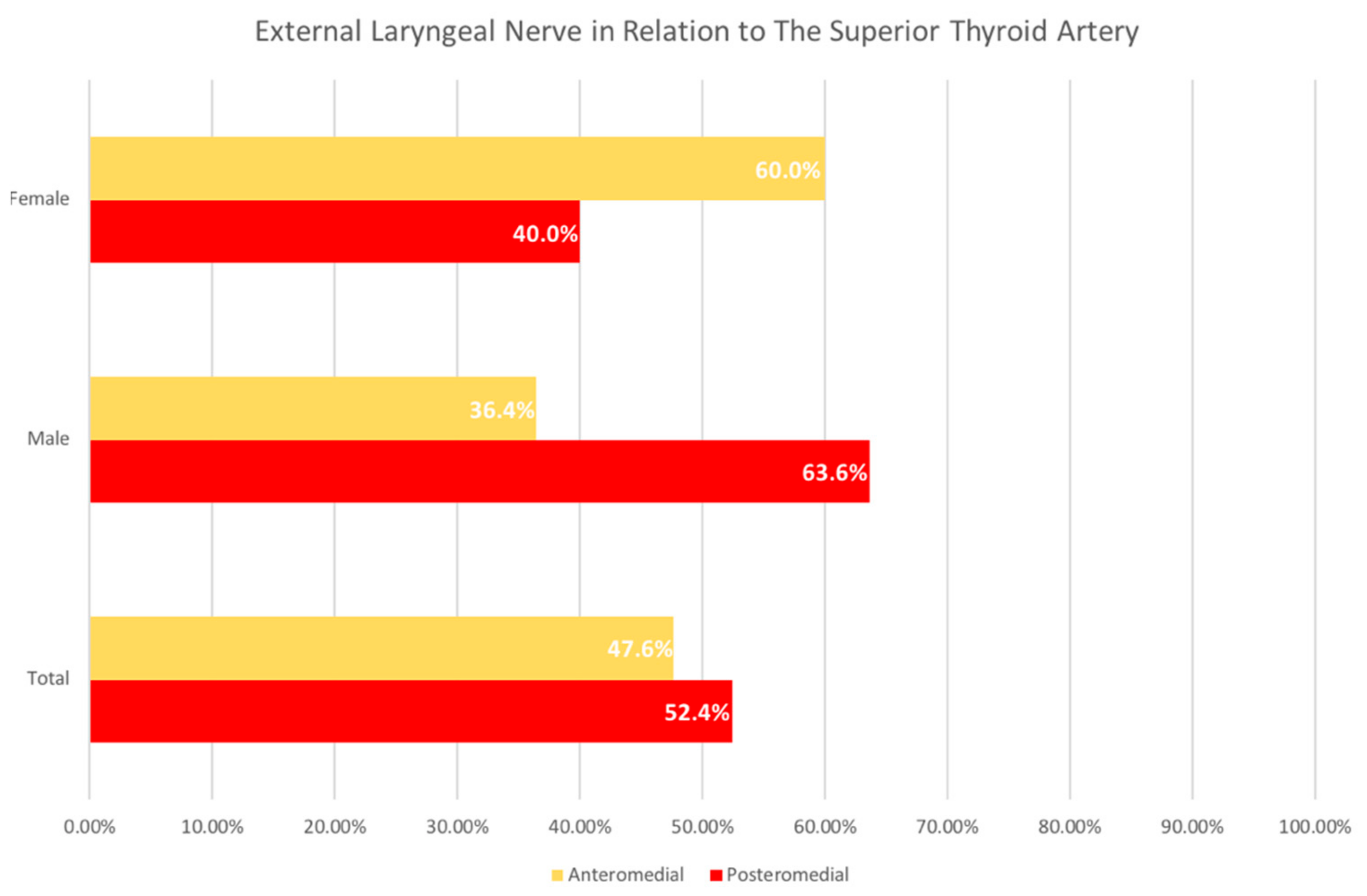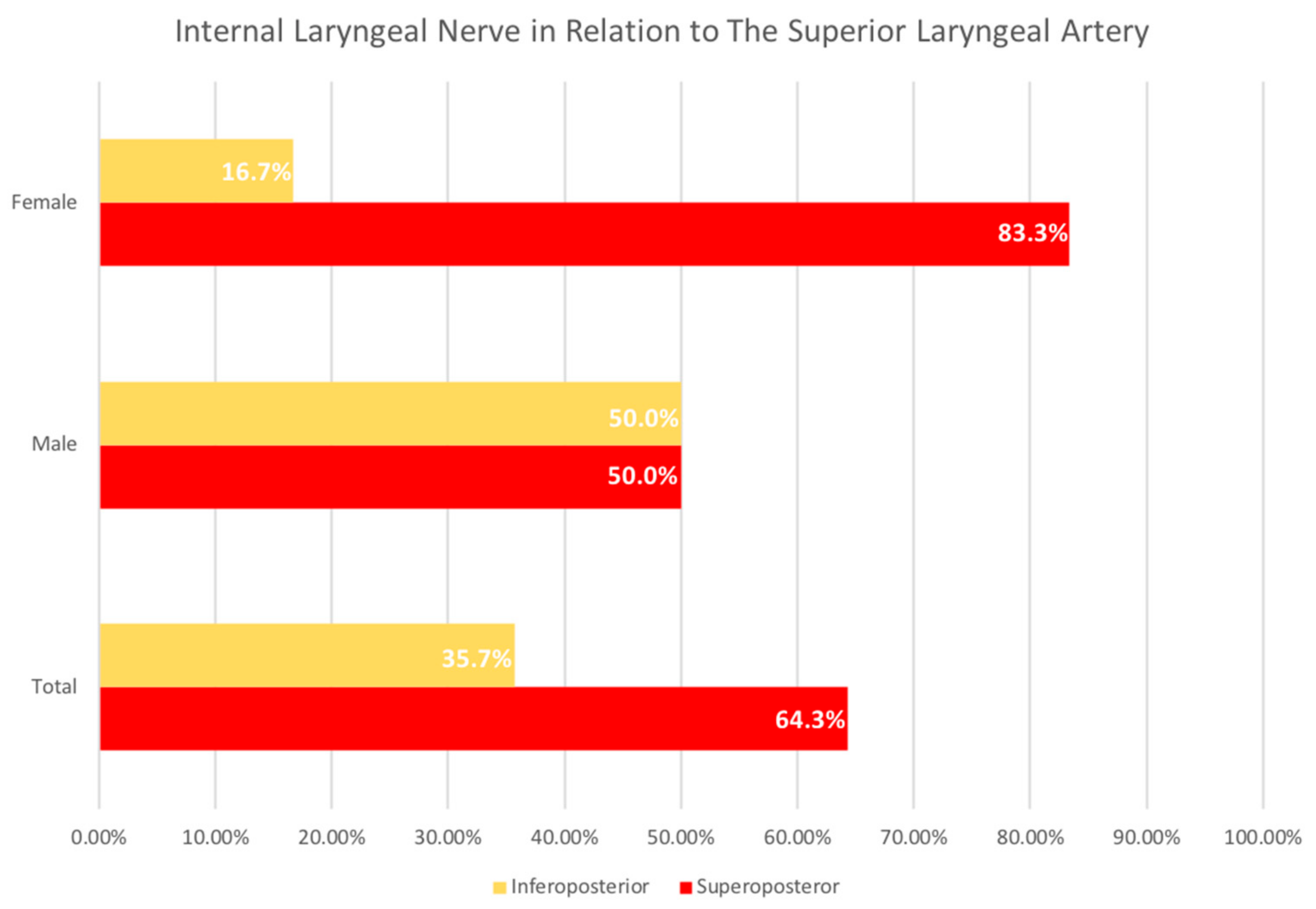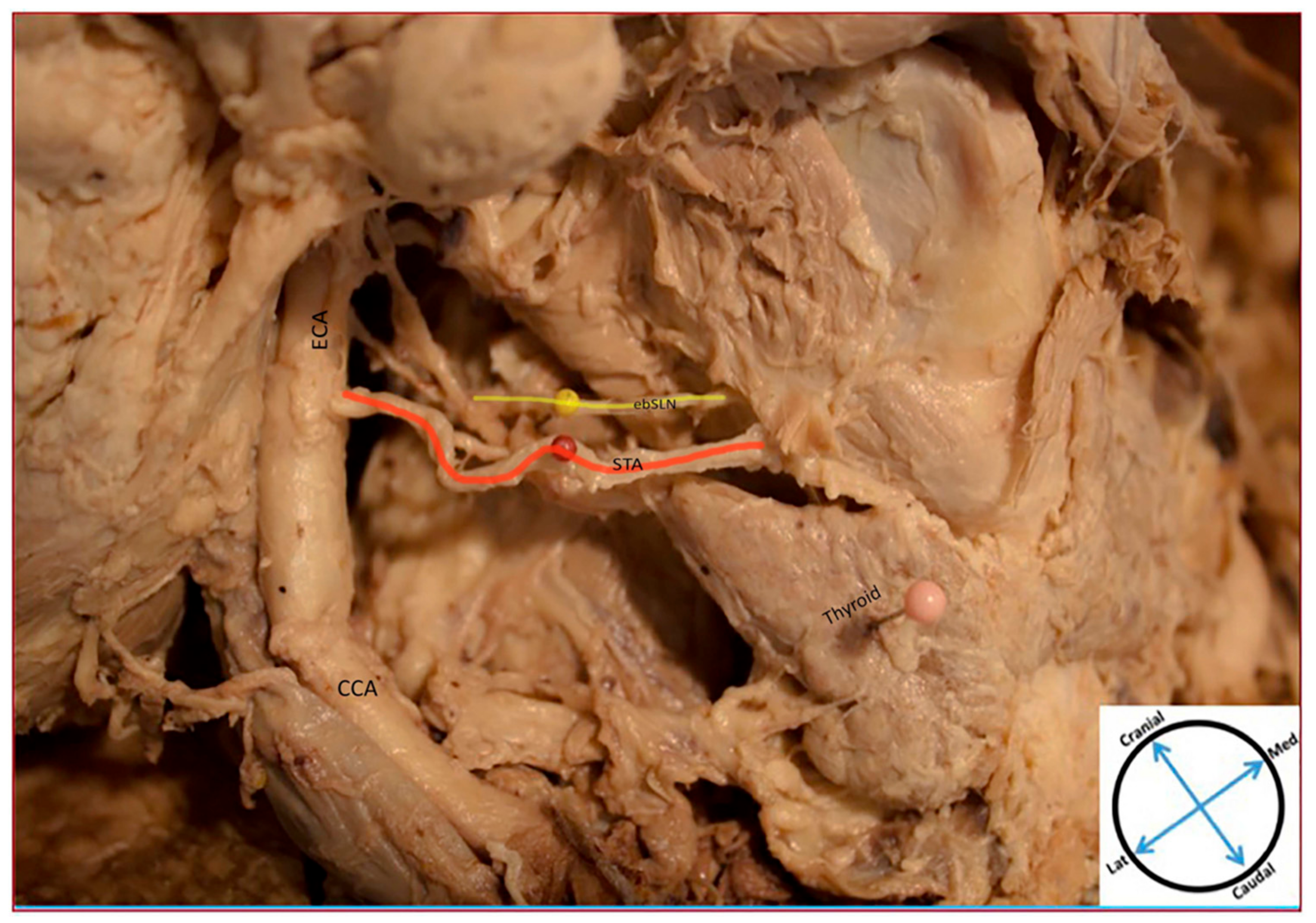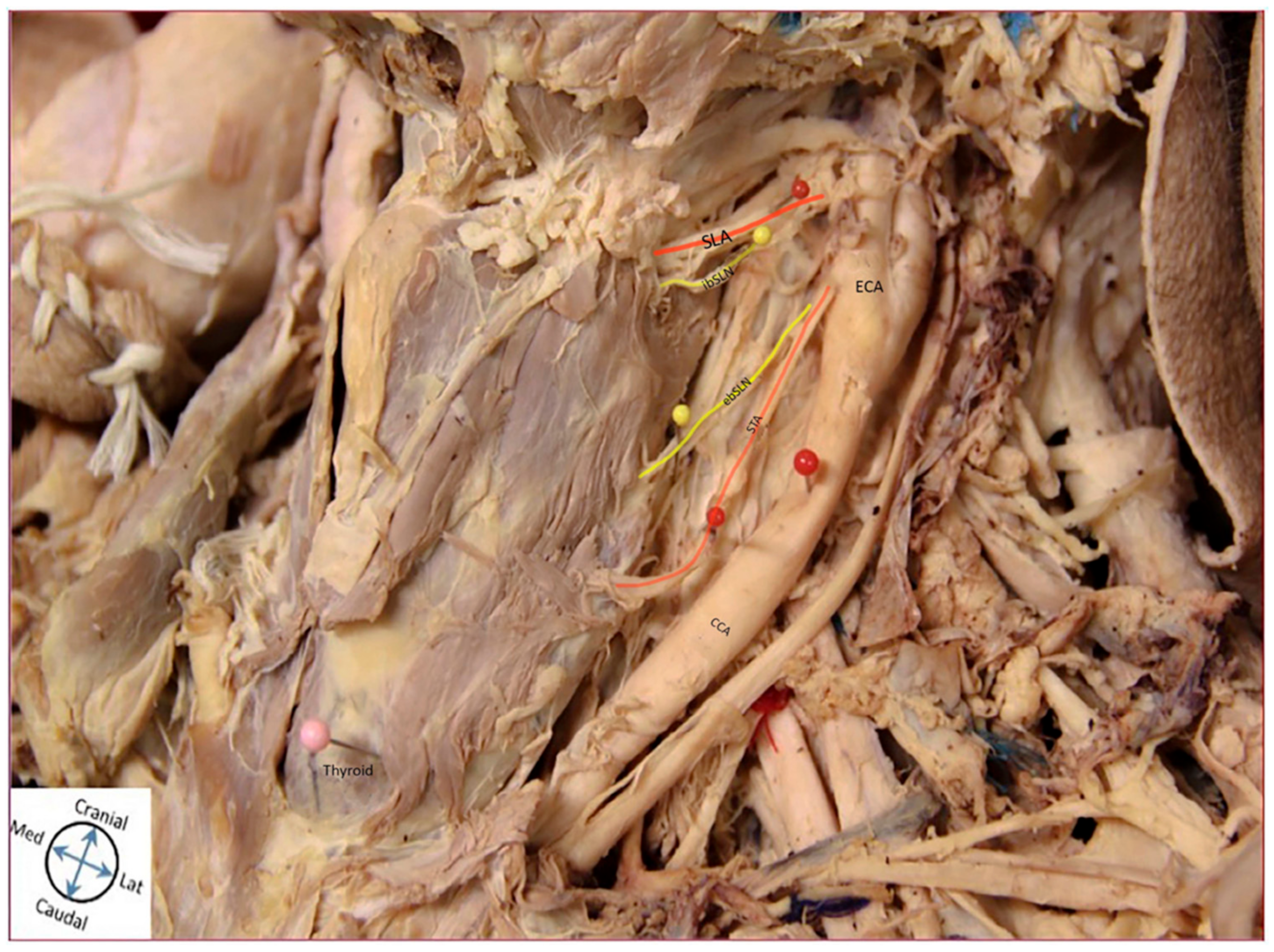The Superior Laryngeal Nerve and Its Vulnerability in Surgeries of the Neck
Abstract
:1. Introduction
2. Materials and Methods
3. Results
4. Discussion
5. Conclusions
Supplementary Materials
Author Contributions
Funding
Institutional Review Board Statement
Informed Consent Statement
Acknowledgments
Conflicts of Interest
References
- Cheruiyot, I.; Kipkorir, V.; Henry, B.M.; Munguti, J.; Cirocchi, R.; Odula, P.; Wong, L.M.; Olabu, B.; Walocha, J. Surgical anatomy of the external branch of the superior laryngeal nerve: A systematic review and meta-analysis. Langenbeck’s Arch. Surg. 2018, 403, 811–823. [Google Scholar] [CrossRef] [PubMed]
- Kiray, A.; Naderi, S.; Ergur, I.; Korman, E. Surgical anatomy of the internal branch of the superior laryngeal nerve. Eur. Spine J. 2006, 15, 1320–1325. [Google Scholar] [CrossRef] [Green Version]
- Okamoto, N.; Azuma, S. Upper cervical anterior fusion with a particular focus on superior laryngeal nerve and hypoglossal nerve. Spine Surg. Relat. Res. 2018, 2, 121–126. [Google Scholar] [CrossRef] [PubMed]
- Paraskevas, G.K.; Raikos, A.; Ioannidis, O.; Brand-Saberi, B. Topographic anatomy of the internal laryngeal nerve: Surgical considerations. Head Neck 2011, 34, 534–540. [Google Scholar] [CrossRef]
- Potenza, A.S.; Filho, V.J.F.A.; Cernea, C.R. Injury of the external branch of the superior laryngeal nerve in thyroid surgery. Gland. Surg. 2017, 6, 552–562. [Google Scholar] [CrossRef] [Green Version]
- Delbridge, L. The ‘neglected’ nerve in thyroid surgery: The case for routine identification of the external laryngeal nerve. ANZ J. Surg. 2001, 71, 199. [Google Scholar] [CrossRef]
- Hermann, M.; Alk, G.; Roka, R.; Glaser, K.; Freissmuth, M. Laryngeal Recurrent Nerve Injury in Surgery for Benign Thyroid Diseases. Ann. Surg. 2002, 235, 261–268. [Google Scholar] [CrossRef]
- Friedman, M.; Wilson, M.N.; Ibrahim, H. Superior laryngeal nerve identification and preservation in thyroidectomy. Oper. Tech. Otolaryngol. Neck Surg. 2009, 20, 145–151. [Google Scholar] [CrossRef]
- Chuang, F.-J.; Chen, J.-Y.; Shyu, J.-F.; Su, C.-H.; Shyr, Y.-M.; Wu, C.-W.; Lui, W.-Y.; Lee, C.-S.; Chen, T.-H. Surgical anatomy of the external branch of the superior laryngeal nerve in Chinese adults and its clinical applications. Head Neck 2009, 32, 53–57. [Google Scholar] [CrossRef]
- Dessie, M.A. Variations of the origin of superior thyroid artery and its relationship with the external branch of superior laryngeal nerve. PLoS ONE 2018, 13, e0197075. [Google Scholar] [CrossRef] [PubMed]
- Estrela, F.; Leão, H.Z.; Jotz, G. Anatomic relation between the external branch of the superior laryngeal nerve and the thyroid gland. Braz. J. Otorhinolaryngol. 2011, 77, 249–258. [Google Scholar] [CrossRef] [Green Version]
- Güven, E.M.; Karacan, K.; Güven, M.; Elden, H.; Korkmaz, M. Özçelik Topographic anatomy of the ınternal branch of the superior laryngeal nerve. Eur. Arch. Otorhinolaryngol. 2021, 278, 727–731. [Google Scholar] [CrossRef] [PubMed]
- N’Guessan, L.; Chatigre, R.; Koffi, D.N.; Kassanyou, S. Variations anatomiques du nerf laryngé externe et chirurgie thyroïdienne: À propos de 32 dissections. Morphologie 2010, 94, 107–113. [Google Scholar] [CrossRef] [PubMed]
- Sreedharan, R.; Krishna, L.; Shetty, A. Origin of superior thyroid artery: Under the surgeon’s knife. J. Vasc. Bras. 2018, 17, 290–295. [Google Scholar] [CrossRef] [PubMed]
- Whitfield, P.; Morton, R.P.; Al-Ali, S. Surgical anatomy of the external branch of the superior laryngeal nerve. ANZ J. Surg. 2010, 80, 813–816. [Google Scholar] [CrossRef]
- Yalcin, B.; Develi, S.; Tubbs, R.S.; Poyrazoglu, Y. A detailed study of the relationship between the external laryngeal nerve and superior thyroid artery, including its glandular branches. Clin. Anat. 2012, 26, 814–822. [Google Scholar] [CrossRef]
- Aluffi, P.; Policarpo, M.; Cherovac, C.; Olina, M.; Dosdegani, R.; Pia, F. Post-thyroidectomy superior laryngeal nerve injury. Eur. Arch. Otorhinolaryngol. 2001, 258, 451–454. [Google Scholar] [CrossRef]
- Hurtado-Lopez, L.M.; Pacheco-Alvarez, M.I.; Montes-Castillo, M.D.L.L.; Zaldivar-Ramirez, F.R. Importance of the Intraoperative Identification of the External Branch of the Superior Laryngeal Nerve During Thyroidectomy: Electromyographic Evaluation. Thyroid 2005, 15, 449–454. [Google Scholar] [CrossRef]
- Ragona, R.M.; Restivo, D.; Mylonakis, I.; Ottaviano, G.; Martini, A.; Sataloff, R.; Staffieri, A. The superior laryngeal nerve injury of a famous soprano, Amelita Galli-Curci. Acta Otorhinolaryngol. Ital. 2013, 33, 67–71. [Google Scholar]
- Barczyński, M.; Randolph, G.W.; Cernea, C.R.; Dralle, H.; Dionigi, G.; Alesina, P.F.; Mihai, R.; Finck, C.; Lombardi, D.; Hartl, D.M.; et al. External branch of the superior laryngeal nerve monitoring during thyroid and parathyroid surgery: International Neural Monitoring Study Group standards guideline statement. Laryngoscope 2013, 123, S1–S14. [Google Scholar] [CrossRef]
- Ortega, C.; Maranillo, E.; McHanwell, S.; Sanudo, J.; Vázquez-Osorio, T. External laryngeal nerve landmarks revisited. Head Neck 2018, 40, 1926–1933. [Google Scholar] [CrossRef]
- Shin, D.-U.; Sung, J.-K.; Nam, K.-H.; Cho, D.-C. Bilateral Internal Superior Laryngeal Nerve Palsy of Traumatic Cervical Injury Patient Who Presented as Loss of Cough Reflex after Anterior Cervical Discectomy with Fusion. J. Korean Neurosurg. Soc. 2012, 52, 264–266. [Google Scholar] [CrossRef] [PubMed]
- Burt, C.W.; Schappert, S.M. Ambulatory care visits to physician offices, hospital outpatient departments, and emergency departments: United States, 1999–2000. Vital Health Stat. Ser. 13 2004, 13, 1–66. [Google Scholar]
- Simpson, C.B.; Tibbetts, K.M.; Loochtan, M.J.; Dominguez, L.M. Treatment of chronic neurogenic cough with in-office superior laryngeal nerve block. Laryngoscope 2017, 128, 1898–1903. [Google Scholar] [CrossRef] [PubMed]
- Hsu, C.H.; Lin, T.C.; Yeh, C.C.; Ho, S.T.; Wong, C.S. Convulsions during superior laryngeal nerve block—A case report. Acta Anaesthesiol. Sin. 2000, 38, 93–96. [Google Scholar]
- Liu, O.-G.; Chunming, L.; Juanjuan, W.; Xiaoyan, X. Central retinal artery occlusion and cerebral inrfaction following forehead injection with a corticosteroid suspension for vitiligo. Indian J. Dermatol. Venereol. Leprol. 2014, 80, 177–179. [Google Scholar] [CrossRef] [PubMed]





Publisher’s Note: MDPI stays neutral with regard to jurisdictional claims in published maps and institutional affiliations. |
© 2021 by the authors. Licensee MDPI, Basel, Switzerland. This article is an open access article distributed under the terms and conditions of the Creative Commons Attribution (CC BY) license (https://creativecommons.org/licenses/by/4.0/).
Share and Cite
Dekhou, A.S.; Morrison, R.J.; Gemechu, J.M. The Superior Laryngeal Nerve and Its Vulnerability in Surgeries of the Neck. Diagnostics 2021, 11, 1243. https://doi.org/10.3390/diagnostics11071243
Dekhou AS, Morrison RJ, Gemechu JM. The Superior Laryngeal Nerve and Its Vulnerability in Surgeries of the Neck. Diagnostics. 2021; 11(7):1243. https://doi.org/10.3390/diagnostics11071243
Chicago/Turabian StyleDekhou, Antonio S., Robert J. Morrison, and Jickssa M. Gemechu. 2021. "The Superior Laryngeal Nerve and Its Vulnerability in Surgeries of the Neck" Diagnostics 11, no. 7: 1243. https://doi.org/10.3390/diagnostics11071243
APA StyleDekhou, A. S., Morrison, R. J., & Gemechu, J. M. (2021). The Superior Laryngeal Nerve and Its Vulnerability in Surgeries of the Neck. Diagnostics, 11(7), 1243. https://doi.org/10.3390/diagnostics11071243





